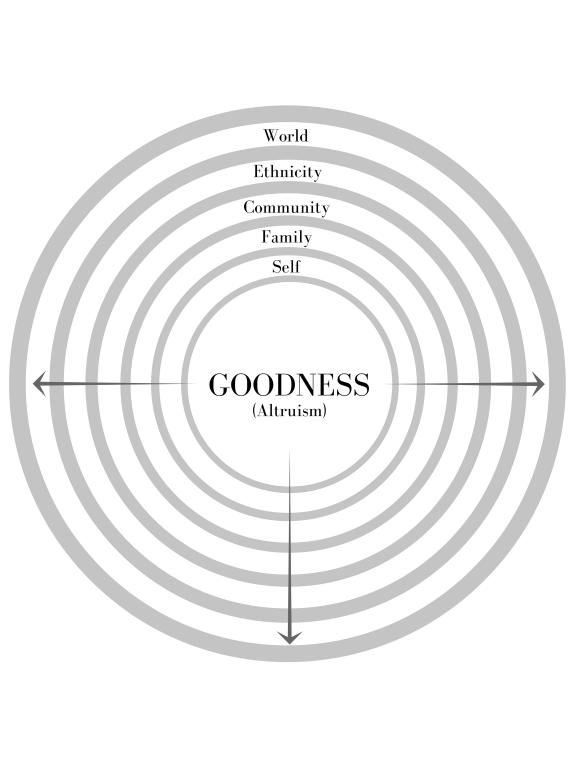
The most famous among moral maxims is “love thy neighbor as thyself” or the Golden Rule. It exists in some form in all religions and is central to the experiential path of goodness. Devotees who follow that path are encouraged to be loving, compassionate, selfless, forgiving and, above all, good.
“Do all the good you can. By all the means you can. In all the ways you can. In all the places you can. At all the times you can. To all the people you can. As long as ever you can.”
John Wesley (1703–1791)
Anglican Cleric and Founder of Methodism
Difficult to Love
Imagine if each person truly loved his or her innermost being altruistically. That person would automatically love and care for others. From an idealistic standpoint, it is easy to envision a peace-loving society if everyone’s cup of inner love were overflowing in that way. The problem is that human beings are notoriously difficult to love. Our bodies have needs that remind us of animal behavior, and we don’t have to look very far to find greed, jealousy, hatred, sexual aggression, and violence—even within ourselves. On top of that, our emotions are messy, and our minds irrational. At first glance, the naked ape is not very lovable.
Potential in Seed Form
Yet, when we look deeper, we find the potential for grace, compassion, love, and all the other virtues of goodness. That potential exists in seed form in most human beings. For the seeds to flower and bloom, however, they need to be nurtured; that is where spiritual and religious practices come in.
Religions vary somewhat in their recipes for cultivating love. Some traditions offer a psychological approach, teaching tolerance, compassion and forgiveness towards oneself in order to be able to extend the same to others, or vice versa, loving others to find love for oneself. Others approach the task by claiming that love in its purest form is Divine; therefore, one should surrender human tendencies, especially destructive ones, and focus on allowing love to flow through oneself rather than trying to create a well within. Still others claim that only through vigilance can the animal nature be tamed so that the Divine can shine through.
Expanding the Circle of Goodness
“All love is expansion, all selfishness is contraction. Love is therefore the only law of life. He who loves lives, he who is selfish is dying. Therefore love for love’s sake, because it is the law of life, just as you breathe to live.”
Swami Vivekananda (1863-1902)
Hindu Monk and Chief Disciple of Ramakrishna
If we combine psychological, spiritual and religious paradigms, we see that expanding the circle of goodness is a process of establishing, transcending, and including. For example, you can establish love for yourself—not the selfish kind, but the caring kind—transcend (expand) that love, and then establish love for another person while at the same time including love for yourself.
 For that to work, however, you first have to use whatever method of increasing love that your religion or spiritual path prescribes. You need to water the seeds of compassion, empathy, and love within and expand that capacity to include more and more people.
For that to work, however, you first have to use whatever method of increasing love that your religion or spiritual path prescribes. You need to water the seeds of compassion, empathy, and love within and expand that capacity to include more and more people.
Ask Questions
If you think about this process of expansion from a personal viewpoint, you can ask yourself questions like: Who are the people I would be willing to show goodness to, and why? Where would I draw the line? How far would my love extend; to my family, community, country, religions, ethnicities, and countries? Would there be a difference between my ability to perform good actions and my ability to extend good thoughts? What would my measuring stick be for goodness?
Beyond Our Close-Knit Circle
Historically, religious life has pushed people of all faiths to go beyond their close-knit circle of family and friends and extend love and compassion to more and more people, including strangers. French-German theologian and physician Albert Schweitzer put his faith into words by saying:
“The demands of Jesus are difficult because they require us to do something extraordinary. At the same time He asks us to regard these [acts of goodness] as something usual, ordinary.”
The same can be said of other prophets and spiritual teachers. They have asked us to aspire, expand, and go beyond what is easy in our efforts to become more loving and compassionate.
Sacrificing in the Name of Love
It is worth noting that expanding in this way requires sacrifices. Becoming a parent is a great example. To care for young children, parents must give up many of their old and often selfish ways. This makes the act of sacrificing for another human being the oldest form of love.
Great servants of humanity have known this.
Take the example of Mohandas ‘Mahatma’ Gandhi. His circle of goodness began with his family, expanded to include the Indian people in South Africa, widened further to include the Indian people in India and, in his final days, he was working for peace in the entire world. One might even say that the inspiring example of his life is still working for global goodness. However, as Gandhi progressed and expanded his circle, he made sacrifices. The time he spent on the road or in prison for a worthy cause took away time that he spent with his family, and some of his children suffered as a result. One, in particular, became an alcoholic and largely blamed his father for the situation. Nevertheless, Gandhi never sacrificed his spiritual practice. He believed that without a source of energy, he would be unable to keep expanding his mission of peace, love, and unity.
Mother Teresa—or Saint Teresa of Calcutta, as she is now known—represents another example. She sacrificed many things, including the ability to have a family of her own, in order to take care of the sick, poor and dying. Still, in the same way as Gandhi, she never sacrificed the time she spent in prayer.
Taking the Long View
A number of the world’s religions take the long view when it comes to increasing one’s capacity for goodness. They instruct people to help moderately with donations of time and money during their working years, to focus on raising a family and being good citizens, but then encourage increased community involvement as time passes, with the knowledge that it is easier to help and serve when people are operating from a surplus and the kids are out of the house.
There are, however, always a chosen few who select a life of service and asceticism at a young age, sacrificing what one would consider a normal life for the privilege of serving a higher power and the community as a whole.
Goodness Exists Because of Duality
“To wish to act like angels while we are still in this world is nothing but folly.”
Saint Teresa of Avila (1515–1582)
Carmelite Nun, Spanish Mystic, and Catholic Saint
For goodness to exist, there has to be an opposite or contrast of some kind. We cannot know what is good unless we also know its antithesis. To see white, we need black. To see light, we need darkness. The same is true about beliefs and values. There is always a choice between two or more options. This is the central truth of duality.
The Attraction-Repulsion Axiom
Within this scope, there exist numerous ways to cultivate capacities for goodness. Most of them fall into one of two opposite categories related to the attraction-repulsion axiom, which says that when people are attracted to what they perceive as good, the built-in human response is to be repelled by the opposite. The stronger the attraction, the stronger the repulsion can become.
For example, if someone is moderately attracted to healthy foods, he or she is only moderately repulsed by unhealthy foods. But once that someone becomes a health nut—affectionately called so by others who do not share the same strong attraction—the natural inclination is to condemn all those who have the occasional candy bar, soda, or fast-food meal and continually rail against sugar- and processed food industries as evil. The example of food is easy to understand, but this principle of attraction and repulsion represents an age-old truth. It was first espoused thousands of years ago and is still true of all persistent efforts to cultivate goodness.
Aspirations and Restrictions
In religious terms, this built-in human tendency creates two approaches.
- The attraction approach is hopeful and positive. The goal is to nurture the seeds of goodness in all forms, including the intentional development of love, compassion, forgiveness, and tolerance.
- The repulsion approach, on the other hand, is vigilant and critical. The goal is to reject everything that is not considered good or appropriate, so labeled either by people independently, by scripture, or by a community of believers.
Owing to the forces of dualism, both approaches exist and have always existed in every religion. One is forever optimistic, the other forever cautious. One believes that there is nothing but good in people, and the other believes that we must resist destructive urges from within and without.
Compassion and Humility
“Compassion is not a popular virtue. Very often when I talk to religious people, and mention how important it is that compassion is the key, that it’s the sine-qua-non of religion, people look kind of balked, and stubborn sometimes, as much to say, what’s the point of having religion if you can’t disapprove of other people?”
Karen Armstrong (1944)
Author and Founder of Charter for Compassion
It takes great humility and awareness to counteract the natural tendency of being repulsed by the opposite of what we are attracted to. We must remind ourselves that even though we consider our chosen path to be good, it is not necessary to offer a blanket condemnation of different approaches without rigorous investigation and contemplation.
As we plod our path towards increased compassion, love, empathy, and altruism, we must never forget that along with strong attraction comes strong repulsion and that although it is sometimes appropriate to rebuff elements of human behavior, being constantly repulsed can subvert our positive efforts and create the exact opposite of what we intended. Our love for one thing can create hate for another if we are not careful.
Simple Question
Developing goodness comes down to a simple question: Will this emotion, thought or action increase or decrease my capacity for goodness? Answer and act.
Gudjon Bergmann
Author and Mindfulness Teacher
Amazon Author Profile
Recommended books:
- Monk of All Faiths: Inspired by The Prophet (fiction)
- Spiritual in My Own Way (memoir)
- Co-Human Harmony: Using Our Shared Humanity to Bridge Divides (nonfiction)
- Experifaith: At the Heart of Every Religion (nonfiction)
- Premature Holiness: Five Weeks at the Ashram (novel)
- The Meditating Psychiatrist Who Tried to Kill Himself (novel)
Picture: CC0 License












